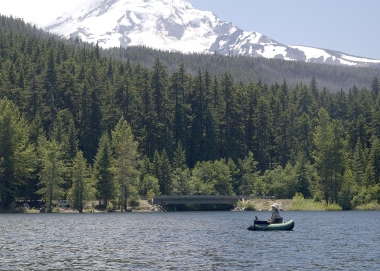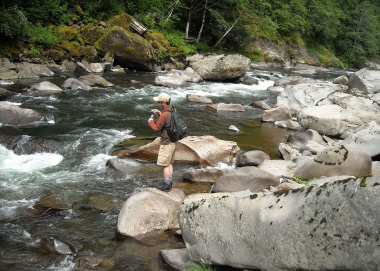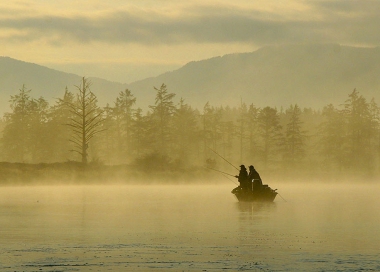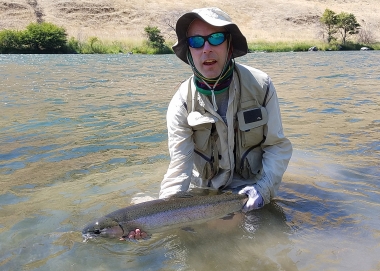
5 tips for fishing in hot water
During summer drought and high temperatures, fish start feeling the heat. Give them a break by following these warm weather fishing guidelines.

When fish are already stressed from low, warm water caused by drought and soaring temperatures, a long fight with an angler could be deadly. Warm water holds less dissolved oxygen than cold water, meaning fish can struggle to breath when water temperatures get high.
Warmwater fish – although more tolerant of warm water conditions -- have their limits, too. So how hot is too hot? Coldwater fish such as trout, steelhead and salmon will start to feel stressed when water temperatures hit 68°F. Warmwater fish can tolerate temperatures up to 86°F, but they’ll probably be sluggish and slow to bite.
When conditions are severe, here are some things anglers can do to help fish:
1. Fish places where water stays cooler
- Go higher. Lakes at higher elevations are generally cooler than those on the valley floors. This is a great time of year to fish some of the hike-in lakes.
- Fish the headwaters. Water temperatures usually cool the higher you go in a river system. Elevations are higher, and streams are small – and more easily shaded by overhanging vegetation.
- Fish deeper. In lakes and ponds, fish will head to deeper, cooler waters. In rivers and streams, look for deeper pools to fish.
- Go to the beach. It’s cooler there and there are great opportunities for bay clamming and surfperch fishing.
- Use your judgement. If conditions where you want to fish seem especially severe (low, hot water), consider fishing somewhere else where water conditions are better. Or even save fishing for another day.
2. Seek cool water refuges
Water temperatures are not consistent throughout a waterbody. Often there are coolers spots where trout and other fish can take refuge from the warmer water.
In rivers and streams, you’ll find cooler waters:
- In deeper pools, often at the head of a riffle.
- Within or just below a riffle or rapid, where water gets oxygenated as it tumbles.
- Along shaded banks.
- In the waters just below cool water tributaries or underground springs.
In stillwaters, look for:
- Deeper, cooler waters.
- Cool water inlets flowing into lakes and reservoirs.
- Shaded banks.
- Water shaded by water plants such as water lilies.
3. Fish during the coolest parts of the day
- Get up early. Fish early in the morning when water temperatures are cooler and fish are more active. You might also beat the swimmers, kayakers, paddle boarders, sailors, water skiers and others that can make fishing a little trickier.
- Stay out late. Water temperatures will start to cool once the sun is off the water. While salmon and trout fishing is off-limits beginning an hour after sunset, you can fish for bass and other warmwater species throughout the night,
4. Land fish quickly, keep them in the water
If you plan to release the fish you catch, landing fish quickly and keeping them in the water as much as possible will help them recover.
- Use the right-size gear and land fish quickly. The longer the fight, the less likely the fish will survive.
- Avoid removing the fish from the water.
- If taking a photo, cradle the fish at water level and quickly take the picture.
- Remove hooks quickly and gently while keeping the fish in the water.
- Use long-nosed pliers or hemostats to back out a hook.
- If a fish is hooked deeply, cut the line near the hook.
- Revive fish (point them into slow current or move them back and forth until gills are working).
- When possible, let the fish swim out of your hands.
No reason to forgo a photo of you and your fish. Scan this article for tips on safely taking fish photos.
5. Check before you go
ODFW tries to reduce angler impact on fish by adopting emergency regulations when conditions are severe. These can include:
- Hoot owl rules. Fishing may be closed in some locations during the hottest part of the day.
- Lifting bag limits in locations likely to go dry. In waters that have been stocked, ODFW may encourage anglers to salvage as many fish as possible before the waterbody runs dry.
- Closures. When water temperatures are very high, ODFW may close some areas to fishing until conditions improve.
Summer drought and high temperatures also increase wildlife risks, and associated road closures. Check for fires and related road closures on Oregon’s interagency status map.
Header image by Roger Smith.





